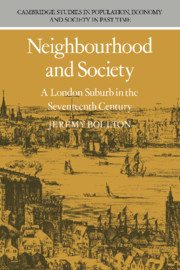Book contents
- Frontmatter
- Contents
- List of figures
- List of tables
- Preface
- Abbreviations
- 1 Introduction
- 2 The demographic background
- 3 Earning a living in early seventeenth-century Southwark
- 4 Wealth and social structure
- 5 Household structure and the household economy
- 6 Power, status and social mobility
- 7 Residential patterns and property ownership
- 8 The dynamics of a local community
- 9 Social relationships in the urban neighbourhood
- 10 The institutional structure of the neighbourhood
- 11 Conclusion: neighbourhood and society in seventeenth-century London
- Bibliography
- Index
2 - The demographic background
Published online by Cambridge University Press: 19 October 2009
- Frontmatter
- Contents
- List of figures
- List of tables
- Preface
- Abbreviations
- 1 Introduction
- 2 The demographic background
- 3 Earning a living in early seventeenth-century Southwark
- 4 Wealth and social structure
- 5 Household structure and the household economy
- 6 Power, status and social mobility
- 7 Residential patterns and property ownership
- 8 The dynamics of a local community
- 9 Social relationships in the urban neighbourhood
- 10 The institutional structure of the neighbourhood
- 11 Conclusion: neighbourhood and society in seventeenth-century London
- Bibliography
- Index
Summary
The demographic record forms an important backdrop to a study of the conditions in which the inhabitants of Southwark lived and worked. Such information enables us to look at such environmental measures as population density and to appreciate the effects of population movements on the local economy, administration and society. Furthermore an examination of the seasonal distribution of baptisms and burials throws valuable light on the annual tempo of life in pre-industrial Southwark.
Although it is well known that the population of London grew rapidly in the late sixteenth and seventeenth centuries it has also been established recently that it grew at different rates in different areas of the capital and that the impact of infant mortality and epidemic disease varied according to the socio-economic composition of each district. It does not follow, therefore, that Southwark shared in the demographic experience of the rest of the capital. Indeed it has been claimed that Southwark's population did not grow significantly in the early seventeenth century. If this were true it might indicate that the social problems sometimes associated with rapid growth in other parts of London were less pressing in Southwark. The extent to which Southwark's population was affected by the rhythm of the seasons might also have differed from the experience of the inhabitants of the wealthier city parishes. Southwark's demographic experience must therefore be investigated directly.
- Type
- Chapter
- Information
- Publisher: Cambridge University PressPrint publication year: 1987

